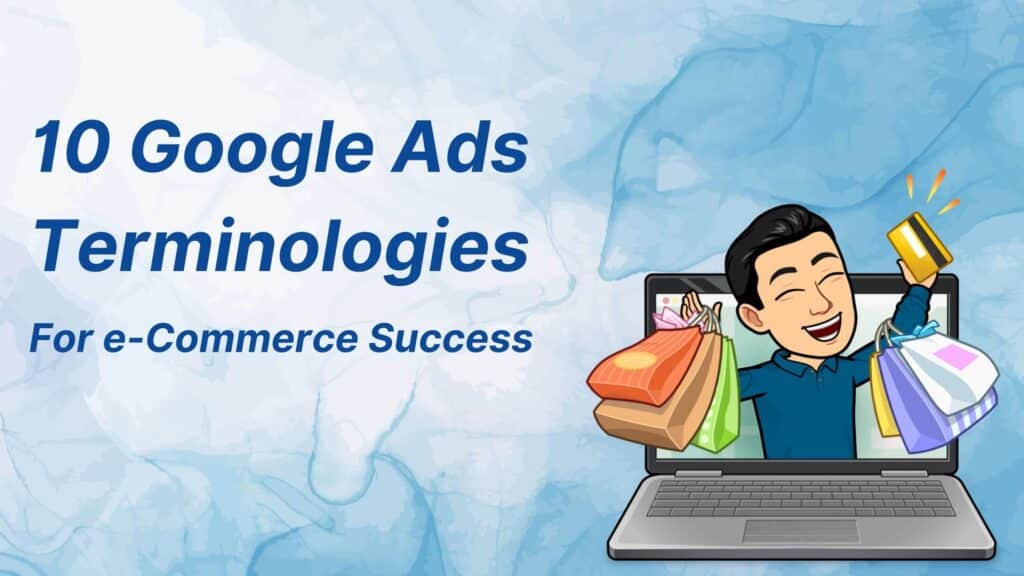
Thank you for taking the time to check out my post, Want me to audit your campaigns on Google and Facebook?

Thank you for taking the time to check out my post, Want me to audit your campaigns on Google and Facebook?

Google Ads Terminologies will be essential for your performance marketing journey.
Whether you’ve experienced brick-and-mortar store work and aim to explore online sales or are stepping into sales for the first time, you might encounter unfamiliar e-commerce terms.
This e-commerce glossary supplies definitions and extra information about terms encountered during the foundational learning of e-commerce.
I will primarily delve into e-commerce terminology centered on tasks preceding serious consideration of e-commerce marketing. However, certain marketing terms will surface as they impact your business plan even in its initial phases.
Now Let’s see my 14 essential google ads terminologies for e-commerce success.
In the digital realm, impressions are like the nods of approval your ads receive. Each time your ad appears on a user’s screen, it counts as an impression. It’s not about interaction; it’s the initial handshake, the acknowledgment that your business exists in the vast online space.
Impressions matter because they measure visibility. The more your ad appears, the more likely users will notice your brand. It’s the first step in the dance of online advertising.
You can easily see this in your Google Ads dashboard under the Impressions Column.
CPM is the cost that you are paying to the Ad platform (In our case it is Google Ads) to get 1000 impressions. This term is visible in the Facebook ads dashboard, but not in the Google Ads dashboard,
Here is the mathematical expression of the same. By using this you can create a custom metric for yourself in Google ads dashboard.
CPM = (Total Ad Spent/Number of Impressions)*1000.
As a performance marketer, you want this number to go down day over day. as you want to reach more people within the same budget that you have decided for your campaign.
If you want to lower your CPM, try to be more active on your social handles, like your Facebook page and Instagram page.
These are nothing but clicks that you will get on your ad. This is the part of BoFu (Bottom of the Funnel) and you need clicks on your ads to get sales of product.
This term you are going to hear again and again, This term will tell you whether the audience is finding your ad relevant or not.
Mathematically, The expression can written as
CTR% = (No. of Clicks/Total Impressions)*100
Assume that 1000 people saw your ad and out of those 1000 people, 112 people clicked on it. so the CTR will be 1.12%
It is very important to monitor the CTR since you want to spend less on ads to get sales from the campaign.
Higher will be beneficial for your campaign.
To Increase CTR, Use Relevant Audience and design Good Creatives with which your potential customer resonates.
It is the cost that you are paying to get a click. Practically you want this cost to be low.
The expression can be written as CPC = (Total Cost/Total no. of Clicks)*100.
Conversion is the main objective of the campaign which you want on your website. In the case of eCommerce, you want this to be purchased.
A bid is nothing but a strategy on which you want to focus for which you are paying Google ads.
If you are a cricket lover, you must have noticed that Mitchell Starc will be the most expensive player for the IPL season 2024.
All 10 teams started bidding for him for higher prices. Similarly, you can also bid for a specific conversion on Google Ads.
Let’s say the maximum cost which you can give for a conversion is Rs.100 so that bidding strategy will be conversion and you can put a threshold for each conversion.
Out of how many people are converting or buying your product after coming to your website.
This metric can tell you about whether your landing page is optimized or not.
assume that 100 people came to your website and 3 people bought the product so the conversion rate will be 3%.
It is the amount that you are paying per conversion, here conversion can be anything that is decided by you.
While creating the campaign, the setup wizard will ask you what you want to be considered as a conversion. It can be Add to Cart, Purchase, Page View, Contact or Lead, etc.
This metric is visible in Google Ads and Facebook Ads too.
It is expressed as:-
CPC = (Amount Spent/No. of Conversion)
Remember you need to first specify the conversion. since we are talking about e-commerce, so I can also say this as Cost Per Purchase.
As the name suggests, it is the return on your investment that you will get after putting the money into ads.
The amount spent by you will be considered as Investment, and Return means the Conversion value which you will get by selling the product.
Hope you learned about the most used google ads terminologies. Remember you need to under the metric at every phase of the Funnel.
For instance, CPM and Impression are a ToFu, Clicks and CTR are at MoFu, and Conversions and Conversion Rates are at BoFu.
But before this, you need to understand the types of Google Ads and how it works.
You need to optimize each metric to get the maximum results out of your campaign.
Till Then.
Rajat “Improving Metrics” Negi